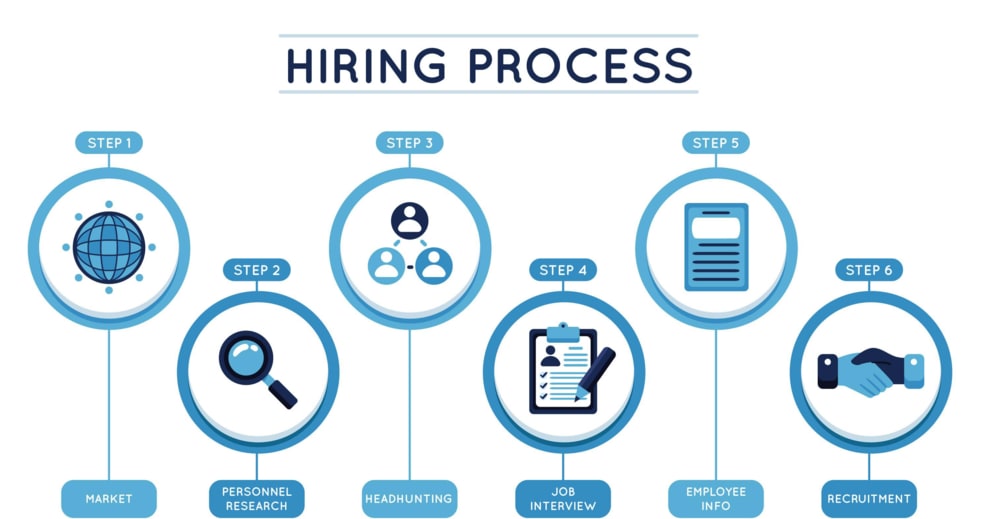Businesses often need help filling their positions. This is especially true in today’s market with the economic hardship that many people are experiencing. Finding the right candidate can be a challenge. Businesses deal with this challenge by using full-cycle recruiting services, including identifying candidates, interviewing them, and hiring them.
The life cycle recruiting process encompasses all stages of the hiring process, from sourcing candidates to onboarding new hires. Using a full cycle recruiting approach can streamline the process and save time and money. This article will discuss what full-cycle recruiting is and how you can implement it in your business. We will also provide useful tips for each stage of the recruitment process. Let’s get started!
What is Full Cycle Recruiting?
Full-cycle recruiting is a recruiting process that encompasses screening, interviewing, and sourcing candidates for an open position. Full-cycle recruiting involves finding qualified candidates and ensuring that these candidates are interested in your company and that they’re ultimately hired.
Many companies use full-cycle recruiting because it helps them find the most qualified candidates for their open positions. It also helps to ensure that these candidates are a good fit for the company and interested in working there.
Full life cycle recruiting can be time-consuming and expensive but finding the best possible candidates for your company is often worth it. With full-cycle recruiting, you can be sure that you’re getting the most qualified candidates and that they’re interested in working for your company.
What are the Benefits of Full Cycle Recruiting?
Now you might be wondering – what are the benefits of full-cycle recruiting? Some of the key benefits include:
Improved candidate quality
The first and most obvious benefit of full-cycle recruiting is that it helps you find the most qualified candidates for your open positions. By screening and interviewing candidates through every step of the process, you can ensure that they’re a good fit for your company.
Just like full-cycle recruiting makes sure that candidates are interested in your company, it also helps you find candidates who are excited about the role they’re applying for. This can be beneficial for retention, as employees who initially show a lot of interest may be more likely to stick around long-term.
 Lower turnover rates
Lower turnover rates
An important thing to remember is that full-cycle recruiting isn’t just about filling open positions – it’s also about making sure that the candidates you hire are interested in working for your company long-term.
By finding candidates who are a good fit for your company and who are excited about the role they’re applying for, you can help lower your turnover rates. This means that you’ll be saving time and money in the long run by hiring the right people the first time around.
Consolidate recruiting processes
If you’re working with multiple recruiters, full-cycle recruiting can help to consolidate the process. By having one person responsible for screening and interviewing candidates, you can ensure that everyone is on the same page. Whether hiring managers, recruiters, or HR professionals, everyone can benefit from implementing full-cycle recruiting.
Reduce time-to-hire
Finally, full-cycle recruiting can help to reduce your time-to-hire. By finding the best candidates and making sure that they’re interested in working for your company, you can fill open positions more quickly.
Even if full-cycle recruiting takes a bit longer upfront, the benefits can be well worth it in the long run. By finding the best candidates and making sure that they’re interested in your company, you can save time and money down the line.
Do you need help mastering full cycle recruiting?
Who Uses Full-Cycle Recruiting?
Full-cycle recruiting is used by a variety of industries and companies, including:
Technology firms
Many technology firms use full-cycle recruiting to find the most qualified candidates for their open positions. With full-cycle recruiting, these companies can be sure that they’re hiring the best possible candidates. Like most companies, they use full-cycle recruiting to save time and money in the long run.
Healthcare organizations
Healthcare organizations often use full-cycle recruiting to find candidates who are a good fit for their open positions. By screening and interviewing candidates thoroughly, these organizations can ensure that they’re hiring the best possible candidates.
Manufacturing companies
Many manufacturing companies also use full-cycle recruiting to find the most qualified candidates for their open positions. By working with a recruiting agency, these companies can be sure that they’re getting top-notch candidates from all over the country.
Retail businesses
Retail businesses often use full-cycle recruiting to find candidates who are a good fit for their open positions. By screening and interviewing each candidate, these companies can be sure that they’re hiring the best possible candidates. Further, by using full-cycle recruiting, retail businesses can save time and money in the long run.
Full-cycle recruiting agencies
Full-cycle recruiting agencies work with various companies to help them find the best candidates for their open positions. By screening and interviewing each candidate thoroughly, these agencies can be sure that they’re hiring the best possible candidates. Every full-cycle recruiter works differently, so you’ll want to find one that works best for your company.
In-house full cycle recruiters
Some companies hire in-house full-cycle recruiters to help with their recruiting process. These individuals are responsible for screening and interviewing candidates and finding new candidates using a variety of tools and techniques.
As you can see, many different industries and companies use full-cycle recruiting. By taking the time to carefully screen and interview candidates, you can be sure that you’re hiring the best possible people for your open positions.
How to Implement Full Cycle Recruiting in Your Business
There are a few different steps that are involved in full-cycle recruiting. These steps include:
Identifying open positions
The first step in full-cycle recruiting is to identify open positions. To do this, you may need to review the performance of your current employees and determine if any of them are looking to move on. Since the recruitment life cycle is long and involved, you’ll want to start this process as early as possible.
You may also want to look at hiring needs that other team members have identified. You may find that you need to hire for a new position, that the needs of your team have changed and that you need more employees in some areas.
Writing job descriptions
Once you’ve identified open positions, it’s time to write up job descriptions. This is important because it helps ensure that your company attracts quality candidates interested in working long-term. It also helps set expectations for your candidates to know what they’re getting themselves into.
Posted job descriptions
The next step in full-cycle recruiting is to post the job description online and on other platforms where you typically advertise open positions. If you have connections with local colleges or universities, this is a good time to reach out to them.
When posting the job description, include all of the information that candidates will need to apply. This might include a deadline for when applications are due, so interested candidates can ensure they don’t miss it.
Screening candidates
After posting the job descriptions, it’s time to start screening candidates. To do this, you’ll need to review resumes and cover letters. You may also want to conduct initial phone interviews with candidates to understand their qualifications better.
In screening candidates, it’s important to be as objective as possible. This means knowing what skills and qualifications are required for the position and only moving on to candidates who have those qualifications.
Interviewing candidates
Once you’ve screened your candidates, the next step is to conduct in-person interviews. This gives you a chance to meet with them face to face and get a better sense of their qualifications and personalities.
While interviewing candidates, it’s important to ask questions that will help you assess their qualifications. You should also ask questions about their career goals and how they would fit into your company.
Let us help you manage your full cycle recruiting process now!
Making an offer
After you’ve interviewed candidates, it’s time to make an offer. This is the final step in full-cycle recruiting, and it’s important to take your time when making an offer.
You should only make an offer to a candidate if you’re confident that they’re the right fit for your company. Be sure to review their qualifications and consider their career goals before making an offer.
Onboarding
After you’ve made an offer and the candidate has accepted, it’s time to onboard them. This is getting them acclimated to your company and their new role.
Onboarding can include various activities, such as orientations, training, and shadowing. Ensuring that your onboarding process helps your new employees feel comfortable and confident in their new roles is important.
If you want to implement full-cycle recruiting in your business, starting with the steps above is important. By focusing on each of these steps, you’ll be able to find the right candidates for your open positions and ensure that they’re a good fit for your company.
Tips for Each Stage of the Full Cycle Recruiting Process
1. To identify open positions, it is important to be proactive and stay up-to-date on the performance of your current employees. This will allow you to spot potential openings as they arise.
2. When writing job descriptions, it is important to be as specific as possible to attract quality candidates who are a good fit for your company.
3. To promote job listings, you may want to consider advertising on social media or partnering with local colleges and universities. This can help reach a wider pool of candidates looking for work.
4. When screening candidates, it’s important to carefully look at their resumes and cover letters to identify the top talent available.
5. To conduct interviews effectively, be sure to take notes during each interview to stay organized and refer back to them as needed.
6. Once you’ve made an offer to a candidate, it is important to make sure that they are onboarded effectively to help them start their new role successfully. This may include providing training and support during the first few weeks.
7. To ensure that your full-cycle recruiting process is effective, regularly measure the results. This may include tracking the number of positions filled, the quality of candidates hired, and the retention rate of new employees.
By following these tips, you can ensure that your company is following a best practice approach to full-cycle recruiting. This will help you hire the best possible employees for your open positions.
Final Words on Full-Cycle Recruiting
Full-cycle recruiting is a process that can help companies of all sizes to find top talent for their open positions. By taking the time to screen and interview candidates thoroughly, these companies can be sure that they’re making the best possible hiring decisions. Whether you are a small business or a large corporation, full-cycle recruiting can be an effective way to find the right employees for your needs.
We hope this article has given you a better understanding of full-cycle recruiting and how it can benefit your business.
Growth Hackers is an award-winning HubSpot marketing agency helping businesses from all over the world grow. There is no fluff with Growth Hackers. We help entrepreneurs and business owners ensure effective full-cycle recruiting processes are in place, start recruitment agencies, generate qualified leads, optimize their conversion rate, gather and analyze data analytics, acquire and retain users and increase sales. We go further than brand awareness and exposure. We make sure that the strategies we implement move the needle so your business grow, strive and succeed. If you too want your business to reach new heights, contact Growth Hackers today so we can discuss about your brand and create a custom growth plan for you. You’re just one click away to skyrocket your business.


 Lower turnover rates
Lower turnover rates




